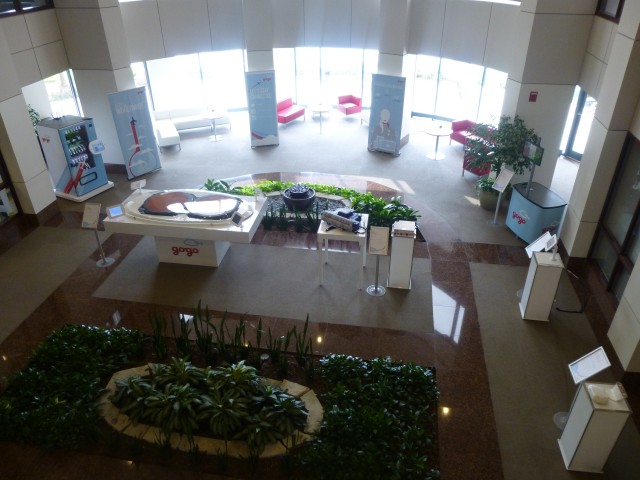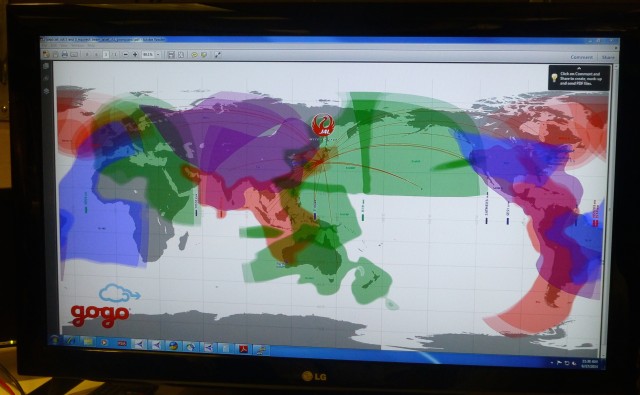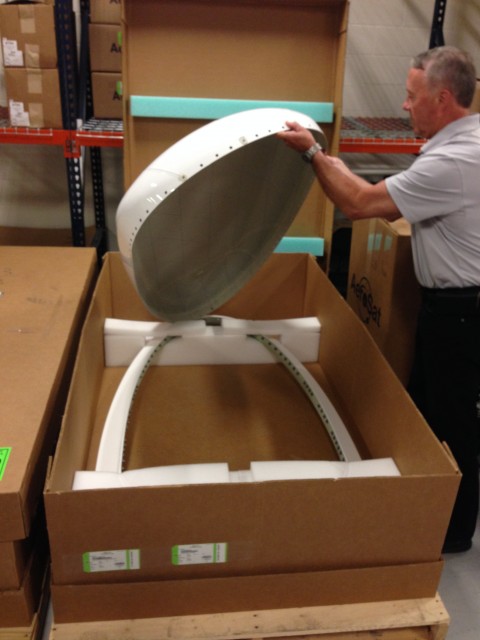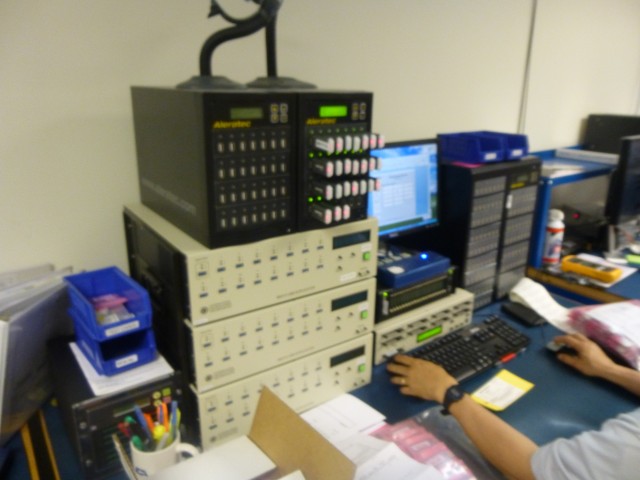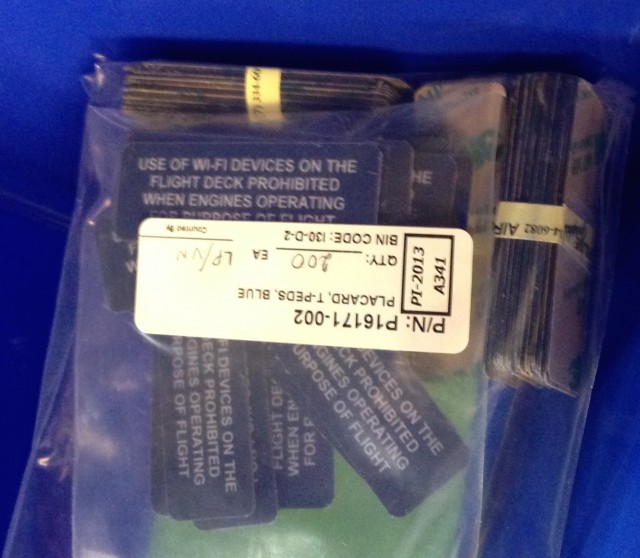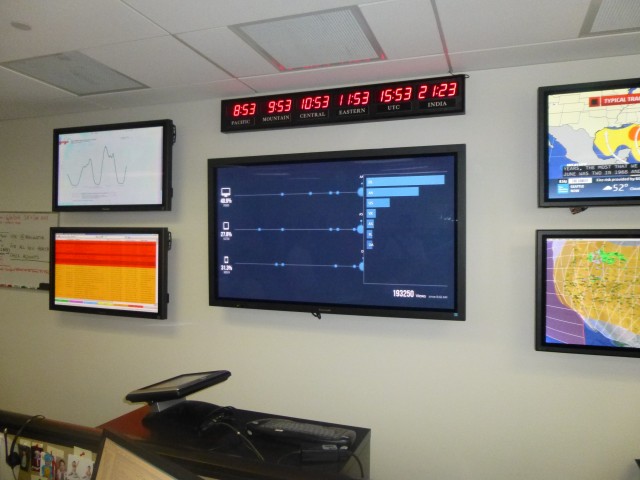As a frequent flier, the novelty of in-flight internet has (mostly) worn off for me. After a full day of presentations, tours, and demonstrations at Gogo, I can promise you that I’ll never take it for granted again. Gogo invited me as part of a group of journalists from both the travel and tech sectors to take part in a day-long “all access” event at their headquarters, near Chicago O’Hare airport.
Gogo is the largest provider of in-flight connectivity, with over 2,000 commercial planes equipped and 6,000 business jets. Originally known as Aircell (and a lot of equipment I saw still had that name on it), the company was founded in 1991 to provide in-flight telephone access. In 2008, Gogo launched in-flight broadband on their first commercial flight, and our lives as fliers has never been the same.
Upon arrival at Gogo HQ, it was clear that the day was a big one for the company. Everywhere we went, there were smiling staff members in matching shirts. Large interactive technology displays were set up in the lobby for us to tinker with.
The day began with a presentation from Gogo’s CEO Michael Small talking about the variety of technologies the company has evolved through, as well as what is on the horizon. Here’s a hint – how do you feel about 70Mbps from 37,000 feet?
The Gogo service that you’re likely familiar with right now is the “ATG” system – or Air-to-Ground – which is based upon a network of cell tower-like antennas on the ground. These are scattered across the country, with some located in very remote and rugged terrain. They need clear line-of-site access, so you’re likely to find them on top of mountains and ridges. The newest versions of this service offer speeds to the plane of about 10mbps. Once you divvy up this bandwidth amongst the passengers, you’ve got enough speed for things like email and twitter, but anything beyond that is unlikely.
What’s new (and fast!) is Gogo’s Ku satellite-based connectivity, which is being used, or coming soon, in a variety of applications. Delta Air Lines currently has 15 planes (and growing) in their international fleet outfitted with the Ku connectivity, which provides about 30mbps, and Japan Airlines is just about to activate the service on their fleet. Using this tech, things are about to get really cool.
In North America, we’ll be getting GTO (Ground-to-Orbit), a hybrid system which utilizes Ku satellite service for downloads, and the ATG network for uploads. Using that combo, service to the plane should be in the 60-70mbps range – more than enough for a quality high-speed link for passengers to do whatever they like.
Internationally, Gogo will roll out their 2Ku system, which utilizes dual cutting-edge technology antennas to deliver 70mpbs+ speeds. The new antennas, which are currently licensed only to Gogo, have multiple benefits. The first is that they are incredibly slim, allowing for a lower-profile radome that increases aerodynamic efficiency (i.e., saves gas). The second benefit is that they are great for dealing with an issue called “Skew Angle”.
I won’t try to go in to the tech involved here (I’m not sure I totally understood it myself), but essentially, the new antennas can better pinpoint a specific satellite without any “bleed” on to neighboring satellites. Particularly problematic at equatorial latitudes, this bleed requires power to be reduced on the system – which reduces speed. 2Ku eliminates this problem.
We got to tour through all of Gogo’s labs, where we had full access to the test engineers, equipment, and new projects. One interesting service, launching in late 2014 with Alaska Airlines, is Gogo Vision. Gogo Vision is an on-demand content streaming service that requires no connectivity to the plane.
Passengers use their own devices – phones, tablets, or laptops – which saves airlines from the capital costs associated with in-flight entertainment installations. The service is perfect for an airline like Alaska, which does a good bit of flying between the west coast and Hawaii, where ATG signal isn’t available. As opposed to content on hard drives or tapes, which are cumbersome to install in the field, Gogo is using beefed-up 128GB USB flash drives, which are super easy for a technician to swap on the fly.
On top of touring the labs, we also got to visit Gogo’s warehousing and repair areas; they support all their equipment internally. It was pretty impressive to see that pre-bundled kits were put together, labeled with markings like “AC 767” (Air Canada Boeing 767), with the whole kit able to fit in the back of a pickup truck. Amongst all the thousands of parts bins, my favorite piece was the little sticker that goes in the cockpit, stating “USE OF WI-FI DEVICES ON THE FLIGHT DECK PROHIBITED WHEN ENGINES OPERATING FOR PURPOSE OF FLIGHT”. Wish I could have snagged one of those.
Another cool part of the day was getting to spend time with Gogo’s customer support personnel. Gogo has a 24/7 support operation which responds to issues via social media, web, and phone. Gogo’s landing page while in-flight actually has the ability to launch a chat for support. The staff reinforced that one of their key goals is to manage expectations. If you’ve got a network hog VPN client that is trying to compete for bandwidth on a business traveler-heavy transcon, you’re not likely to have perfect service. As one executive said, “It’s a complex telecommunications network flying at 500 mph, not a Starbucks hotspot.”
Gogo has been an innovator with in-flight connectivity, and will need to continue that innovation in the face of competition. Big telecom player AT&T recently announced their entrance in to the airborne market, which caused investor panics related to Gogo’s future. That being said, it takes a significant amount of certification to be able to bolt anything on to an airplane, and AT&T is starting from scratch. Gogo is already developing its next generation of technologies. Honestly, if I were Gogo, I’d be more worried about being acquired by AT&T than competing with them.
As I said at the beginning of the article, spending the day with Gogo was a very eye-opening experience. I definitely will not take in-flight connectivity for granted again. The combination of the technology and the people involved behind the scenes is remarkable.


